My researches are mostly focused on imaging of electrical resistivity distribution to understand earthquake, volcanic eruption, and Island arc evolutions. Study of magnetic anomaly have started for ultra-mafic rock and monitoring of active volcano. I also study about tsunami-dynamo effect which should contribute to tsunami source estimations. I sometimes contribute to development of instruments for EM observation. Several figures on my publications are shown bellow.
1. Magnetotelluric (MT) observation and Resistivity imaging
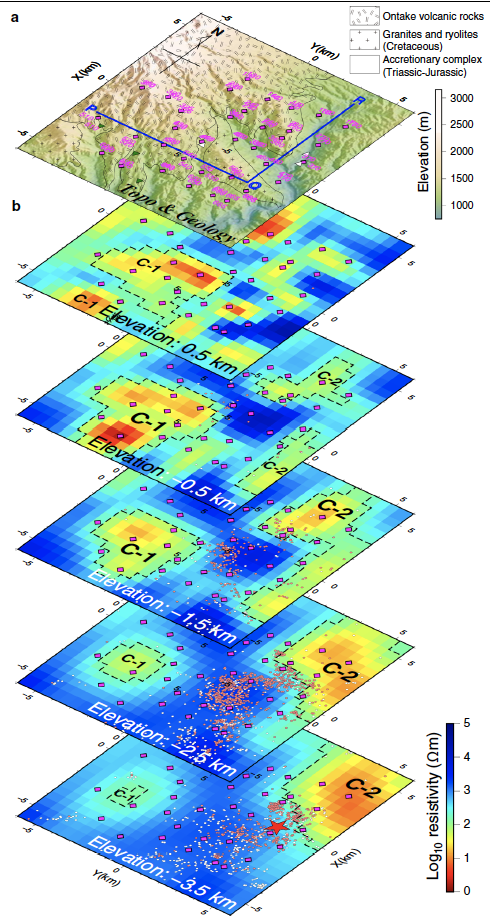
Southeast flank of Mt. Ontake volcano (Ichihara et al., 2018)
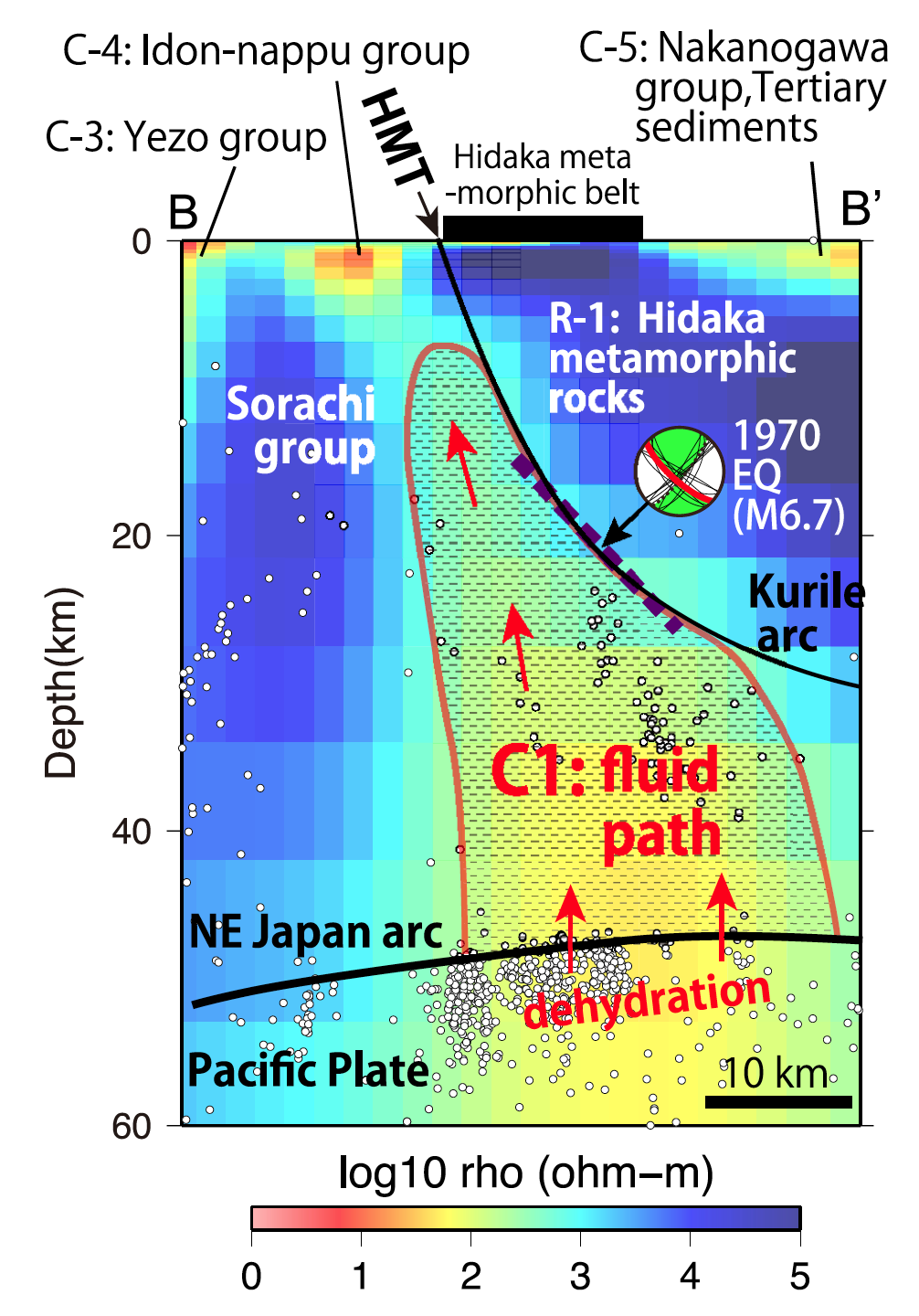
Hidaka collision zone (Ichihara et al., 2016)
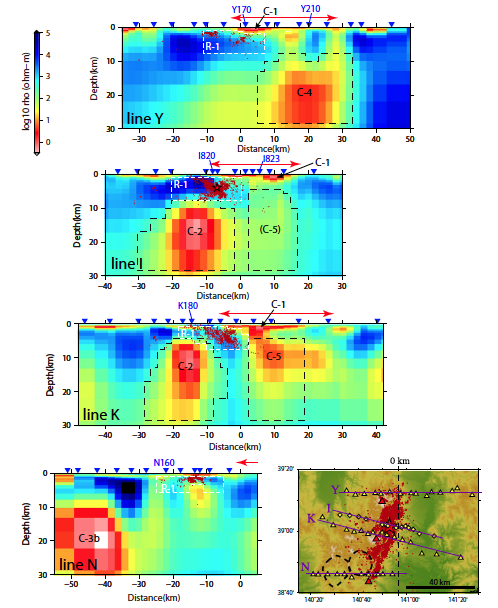
2008 Iwate-Miyagi Nairiku EQ (Ichihara et al., 2014)
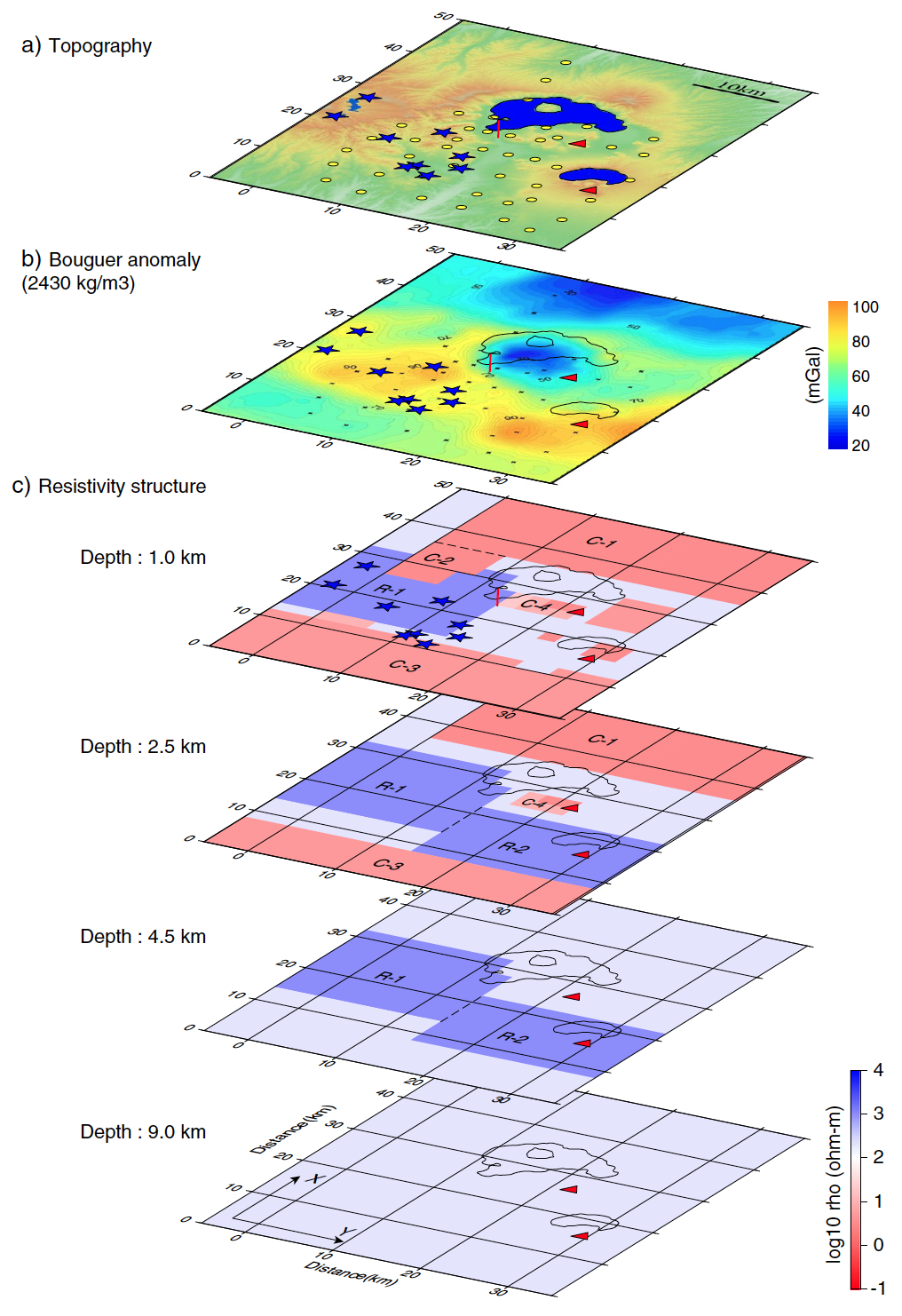
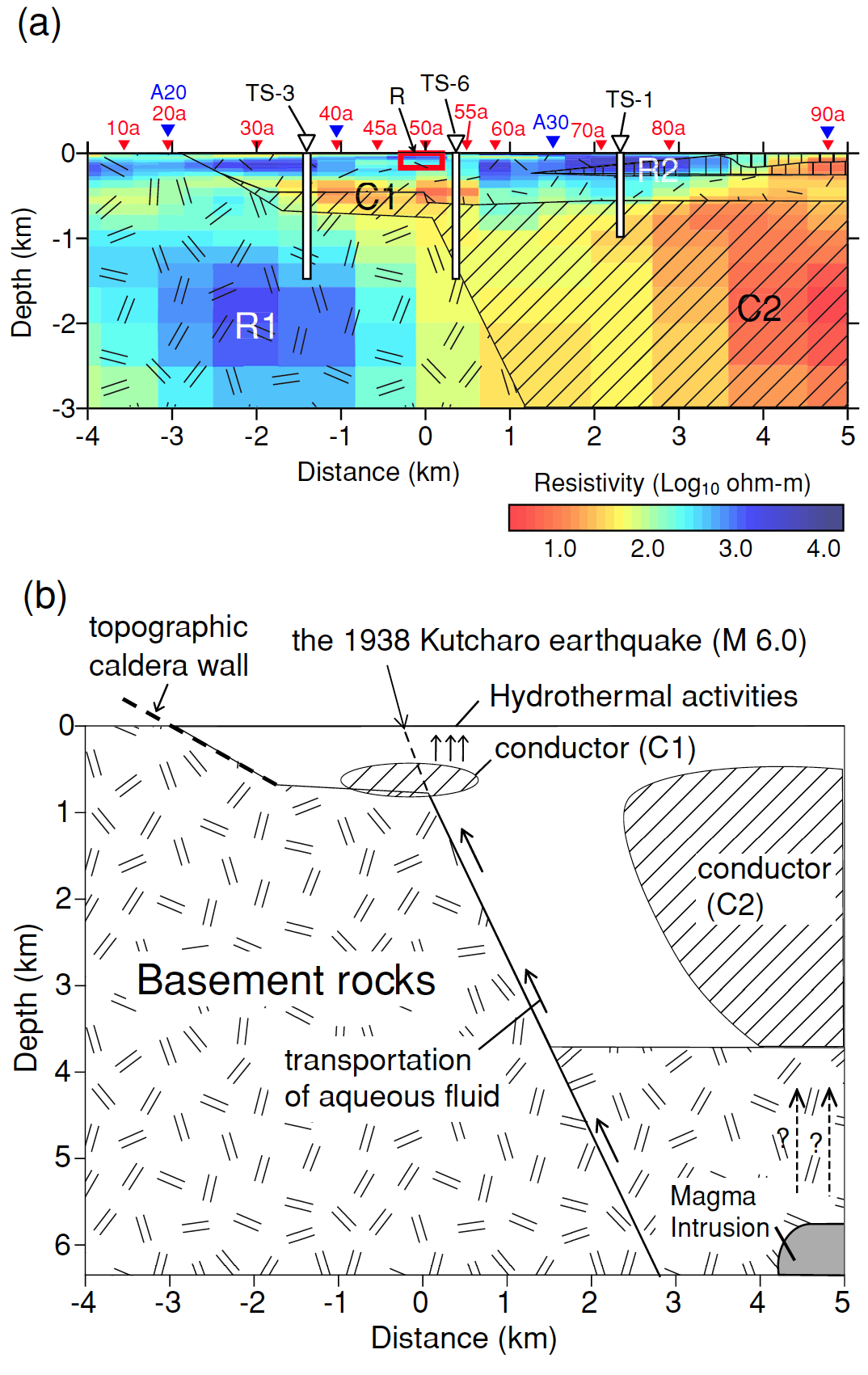
2008 Iwate-Miyagi Nairiku EQ (Ichihara et al., 2014)

Shonai-toen fault (Ichihara et al., 2011)

2004 Rumoi-nanbu EQ (Ichihara et al., 2008)
Targets of ongoing and finished (but unpublished) projects Marine - Off the Miyazaki pref. (Nankai trough EQ and SSE) - Off the Sanriku area (2011 Tohoku-oki EQ) - Eastern Japanese sea (dynamics of subduction zone) - Hikurangi margin (SSE) Land - Seismic swarm area in the east flank of Mt. Ontake volcano - Kutcharo Caldera - northern Hokkaido (seismicity, intra-plate SSE and geology)
2. Tsunami generated electro-manetic field
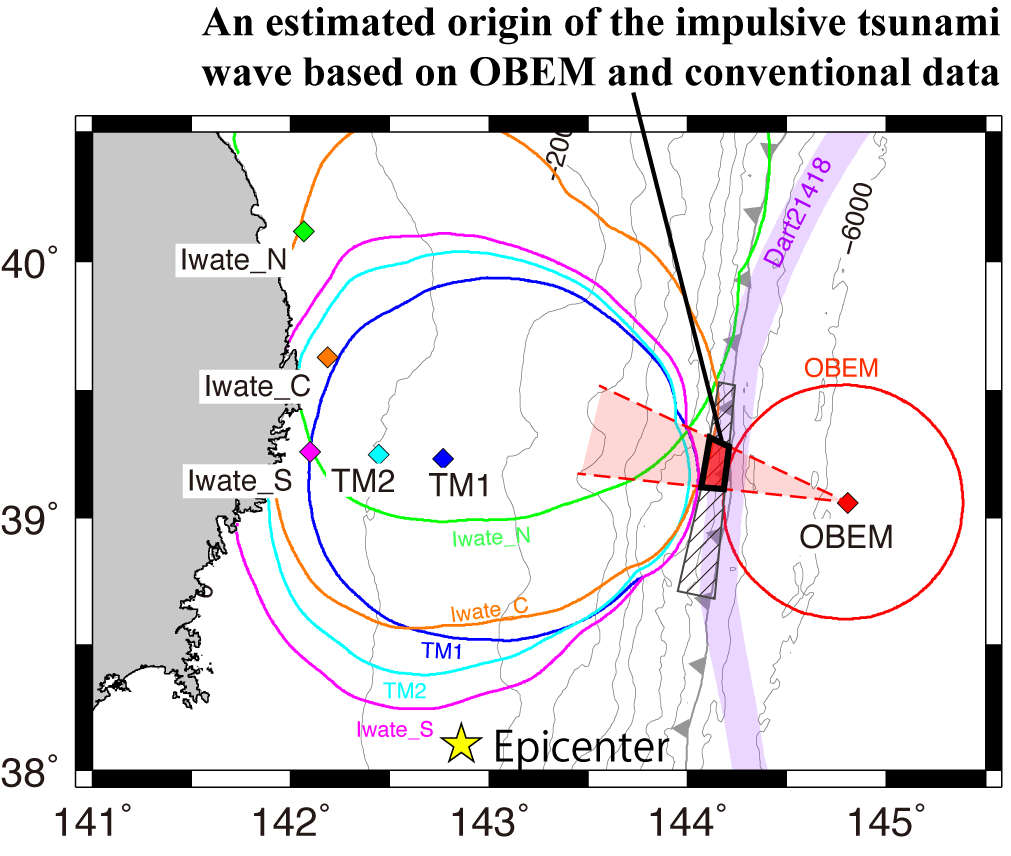
Estimation of tsunami source of the 2011 Tohoku-oki earthquake (Mw9.0) based on OBEM and conventioal data (Ichihara et al., 2013b).
EM data detected propagated direction of the tsunami (dashed line). Solid lines denotes back propagation curves for the impulsive tsunami wave.
See also Ichihara et al. (2013b), Minami et al. (2017) and Tatehata et al. (2015).
3. Anomalous magnetotelluric impedance phase problem
See Ichihara and Mogi (2009), Ichihara et al. (2013b).
4. Gravity & Geomagnetic anomaly
Ichiahra et al. (2009), Baba et al. (2020), Tada et al. (in rev)
5. Development of instruments
Ogawa et al. (2018) etc..
References
Ichihara, H., J. Kanehiro, T. Mogi, K. Yamaoka, E.A. Bertrand, M. Adachi (2018), A 3D electrical resistivity model around the focal zone of the 2017 southern Nagano Prefecture earthquake (MJMA 5.6): implications for relationship between seismicity and crustal heterogeneity , Earth, Planets and Space, 70:182, doi:10.1186/s40623-018-0950-1
Ogawa, K., T. Matsuno, H. Ichihara, K. Nakahigashi and N. Seama (2018), A New Miniaturized Magnetometer System for Long-Term Distributed Observation on the Seafloor, Earth, Planet, Space , 70, doi:10.1186/s40623-018-0877-6
Ichihara, H., and T. Mogi (2009), A realistic 3-D resistivity model explaining anomalous large magnetotelluric phases: the L-shaped conductor model, Geophys J Int, 179(1), 14-17, doi: doi:10.1111/j.1365-246X.2009.04310.x.
Ichihara, H., T. Mogi, and Y. Yamaya (2013a), Three-dimensional resistivity modelling of a seismogenic area in an oblique subduction zone in the western Kurile arc: Constraints from anomalous magnetotelluric phases, Tectonophysics, 603, 114-122, doi:10.1016/J.Tecto.2013.05.020.
Ichihara, H., Y. Hamano, K. Baba, and T. Kasaya (2013b), Tsunami source of the 2011 Tohoku earthquake detected by an ocean-bottom magnetometer, Earth Planet Sc Lett, 382, 117-124, doi:10.1016/J.Epsl.2013.09.015.
Ichihara, H., T. Mogi, H. Hase, T. Watanabe, and Y. Yamaya (2009), Resistivity and density modelling in the 1938 Kutcharo earthquake source area along a large caldera boundary, Earth Planets Space, 61(3), 345-356.
Ichihara, H., R. Honda, T. Mogi, H. Hase, H. Kamiyama, Y. Yamaya, and Y. Ogawa (2008), Resistivity structure around the focal area of the 2004 Rumoi-Nanbu earthquake (M 6.1), northern Hokkaido, Japan, Earth Planets Space, 60(8), 883-888.
Ichihara, H., T. Mogi, K. Tanimoto, Y. Yamaya, T. Hashimoto, M. Uyeshima, and Y. Ogawa (2016), Crustal structure and fluid distribution beneath the southern part of the Hidaka collision zone revealed by 3-D electrical resistivity modeling, Geochem Geophy Geosy, 17(4), 1480-1491, doi: 10.1002/2015gc006222.
Ichihara, H., S. Sakanaka, M. Mishina, M. Uyeshima, T. Nishitani, Y. Ogawa, Y. Yamaya, T. Mogi, K. Amita, and T. Miura (2014), A 3-D electrical resistivity model beneath the focal zone of the 2008 Iwate-Miyagi Nairiku earthquake (M 7.2), Earth Planets Space, 66, Doi 10.1186/1880-5981-66-50.
Ichihara, H., et al. (2011), A fault-zone conductor beneath a compressional inversion zone, northeastern Honshu, Japan, Geophys Res Lett, 38, Doi 10.1029/2011gl047382.
Minami, T., H. Toh, H. Ichihara, and I. Kawashima (2017), Three-Dimensional Time Domain Simulation of Tsunami-Generated Electromagnetic Fields: Application to the 2011 Tohoku Earthquake Tsunami, J Geophys Res-Sol Ea, 122(12), 9559-9579, doi: 10.1002/2017jb014839.
Tatehata, H., H. Ichihara, and Y. Hamano (2015), Tsunami-induced magnetic fields detected at Chichijima Island before the arrival of the 2011 Tohoku earthquake tsunami, Earth Planets Space, 67, doi:10.1186/s40623-015-0347-3.
Copyright © 2020 · All Rights Reserved · Hiroshi Ichihara